Overconsolidation Characteristics of Silt Layer in the Guangdong-Hong Kong-Macao Greater Bay Area
Abstract
In practical engineering projects, overconsolidation plays an irreplaceable role in the calculation of silt consolidation settlement. Based on a series of systematic consolidation tests conducted on reconstituted soft clay in different cities of the Guangdong-Hong Kong-Macao Greater Bay Area, the overconsolidation behavior of soft clay under different depths was studied. According to these tests, the shape of the curves of the overconsolidation ratio with depth was similar to that of the compression curves. Moreover, the deeper the silt depth is, the smaller the overconsolidation ratio is. Hence, the overconsolidation state eventually changes to the underconsolidation state. On this basis, the depths of normal consolidation were calculated through the fitting curves of the overconsolidation ratio with depth by CurveExpert1.4, which is strongly dependent on both the average thickness of the overfill and the range of water level. Based on the results, a polynomial relationship between overconsolidation ratio (OCR) and sampling depth (h) is established. This study can serve as a basis for predicting the consolidation settlement of the silt layer more accurately in practical engineering applications.
1. Introduction
In recent years, with the construction and development of the Guangdong-Hong Kong-Macao Greater Bay Area, underground projects such as urban subways, intercity railways, long-span bridges, high-rise buildings, ports, and large heavy underground structures have entered a trend of development toward larger and deeper areas. However, due to the complex regional geological structure, changeable geotechnical engineering properties, the development of a large area of deep silt layer and sand layer in the Quaternary period, and the rich and active groundwater, the underground engineering construction in this economically developed Bay Area suffers a very adverse impact, among which the collapse and settlement of coastal thick silt soft soil are particularly prominent, leading to frequent engineering accidents.
The ground collapse and settlement are mainly caused by the excessive deformation of the foundation, and the study of the overconsolidation characteristic of the silt layer becomes an important index in the field of foundation deformation research. Due to its special engineering properties, especially the overconsolidation characteristics, the silt layer has become the key object of research in the field of geotechnical engineering. The research history can be traced back to the early 1970s.
In 1972, Bjerrum [1] further studied the e-lgP curve of normally consolidated soil proposed by Crawford in 1964 and obtained the isochronal e-lgP curve, which explained the state of quasi-overconsolidation. Later, Ma [2] deeply analyzed the state caused by secondary consolidation and pointed out that there is a transcendence phenomenon, which was also mentioned by Yasuhara [3]. Gu [4], Zou et al. [5], and Yao et al. [6], respectively, applied the comprehensive judgment method and the stepwise approximation method to determine the early consolidation pressure and then judge the consolidation state of the soil.
In the study on the overconsolidation characteristics of the sludge layer in the Pearl River Delta, Kang et al. [7] have conducted relevant surveys and tests on the marine sludge in Shenzhen. Several pieces of soil with different depths are taken within the depth range of 1.0 m∼13.5 m. The OCR value calculated by the C method of soil within 4.5 m depth is greater than 1, which is overconsolidated soil, while the soil with large buried depth is underconsolidated soil. It is believed that it was once the surface at a buried depth of about 4.5 m and the nearest ground is thickened by new soil on the original ground. However, according to its idea, if the recent ground is the new soil, the situation should be the opposite. The new soil should be underconsolidated and the underlying soil layer is overconsolidated.
Fan et al. [8] pointed out from the structural aspect that since the structural undisturbed sludge has a certain natural structural strength if the PC value is calculated by the C method, the natural structural strength q of the natural soil shall be subtracted from the figure. The deformation behavior of apparent compaction soil caused by structure and overconsolidated soil caused by stress must be different under load. Therefore, underconsolidated soil or normally consolidated soil is easy to be “misjudged” as overconsolidated soil.
The top of the soft clay under an airfield, railway, or highway foundation, which is usually called the crust, is usually overconsolidated under transportation infrastructure [9]. The crust can be produced by surcharge preloading during construction or by transportation in use [10, 11]. For Shanghai clay, the OCR of the surface crust is as high as 8.0 and the clay gradually becomes normally consolidated (OCR = 1) below with different OCR values [11–13].
Qiu and Zhang [14] believed that fine particles contained in the Pearl River Delta silt were suspended in pore water so that the effective weight of the soil was reduced and the density of the soil was increased. The final value of the early consolidation pressure was actually “similar to the early consolidation pressure,” which made the measured value larger. In practice, muck soil in Pearl River Delta should be regarded as underconsolidated soil.
For the causes of overconsolidation, Luo [15] studied the effect of depth on overconsolidated soils with different causes. Based on this, this paper believes that it is not appropriate to directly misjudge such overconsolidated soils, which may be caused by water accumulation or soil filling on the upper layer.
Based on a large number of tests and theoretical analysis, the overconsolidation characteristics of silt have been studied [16–25], including the effects of preconsolidation pressure, consolidation pressure, and overconsolidation ratio on the overconsolidation characteristics.
At present, the research on the overconsolidation characteristics of regional soft soil has not been systematically studied and an appropriate calculation method to predict the overconsolidation ratio (OCR) under different depths (h) has not been put forward for the Guangdong-Hong Kong-Macao Greater Bay Area. Therefore, it is necessary to study the silt layer characteristics of overconsolidation in the Guangdong-Hong Kong-Macao Greater Bay Area.
In this study, the characteristics of overconsolidation of 422 samples of silt layers from 17 projects (7 in Guangzhou, 3 in Shenzhen, 4 in Zhuhai, 2 in Zhongshan, and 1 in Jiangmen) of five typical cities of the Guangdong-Hong Kong-Macao Greater Bay Area are systematically studied. The variation in OCR with the depth is determined. This study can serve as a basis for predicting the consolidation settlement of the silt layer more accurately in practical engineering applications.
2. Materials and Procedures
2.1. Materials
In this paper, tested sludge layers with high moisture content, high void ratio, high compressibility, low bearing capacity, and low permeability were gained from excavations in Nansha of Guangzhou, Shenzhen, Jiangmen, and Zhuhai in the Guangdong-Hong Kong-Macao Greater Bay Area, among which a total of 198 soil samples were collected from Guangzhou, 90 from Shenzhen, 83 from Zhuhai, 32 from Jiangmen, and 19 from Zhongshan, determining the sample size for each region and the size of the sampling projects. Since it is difficult to achieve uniform undisturbed soft clay samples, reconstituted soil was used in this paper. The specific locations of the samples are shown in Figure 1. The main physical and mechanical indicators of the samples for each region are shown in Table 1.
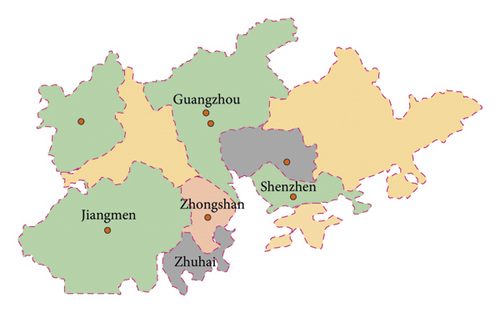
| City | h | ω | e | αV1-2 | cq | φq | Cv1-2 | Kz |
|---|---|---|---|---|---|---|---|---|
| m | % | — | MPa−1 | kPa | ° | 10−3 cm2/s | 10−8 cm/s | |
| Guangzhou | 0.7∼33.8 | 46.3∼85.8 | 1.325∼2.409 | 0.82∼2.36 | 4.8∼14.7 | 0.3∼10.4 | 0.66∼1.5 | 2.1∼14.78 |
| Shenzhen | 0.8∼20.2 | 61.1∼87.4 | 1.5∼2.4 | 1.2∼2.1 | 3.5∼13 | 2.0∼6.4 | 0.62∼0.65 | 22∼23.1 |
| Jiangmen | 3.65∼27.3 | 34.9∼64.2 | 1.016∼1.786 | 0.455∼1.636 | 3.9∼15.4 | 1.9∼17.7 | 1∼2.37 | 4.57∼12.4 |
| Zhuhai | 2.5∼25.5 | 44.6∼69.6 | 1.2∼1.7 | 0.9∼1.6 | 5.3∼8.9 | 2.3∼4.3 | 0.66∼1.05 | 3.2∼29.9 |
| Zhongshan | 2.55∼41 | 52.2∼69.6 | 1.5∼1.885 | 1.1∼1.78 | 5.9∼7.4 | 2.9∼6.7 | 1.05∼1.3 | 6∼7.3 |
2.2. Procedures
The magnitude of preconsolidation pressure (Pc) could be acquired by the Casagrande method which is an empirical method based on the e-lgP curve of undisturbed soil. The Casagrande method is the most traditional and frequently used and applied in the Code for soil tests. According to Figure 2, the specific method is to find the point of minimum radius of curvature on the e-lgP curve and then make a horizontal line, tangent line, and angle bisector of two lines on this point. The vertical pressure corresponding to the intersection point of the angle bisector and the extension line of the straight segment is the initial consolidation pressure.
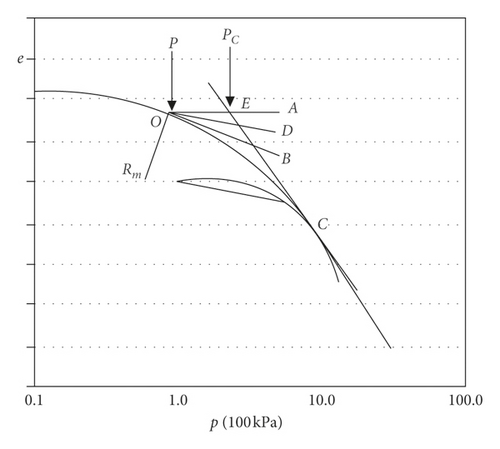
3. Experimental Results and Analysis
3.1. Experimental Results
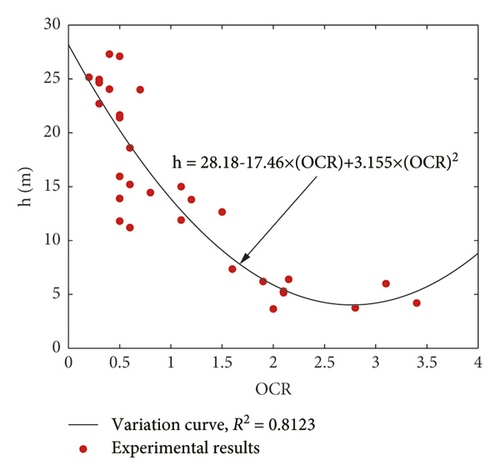


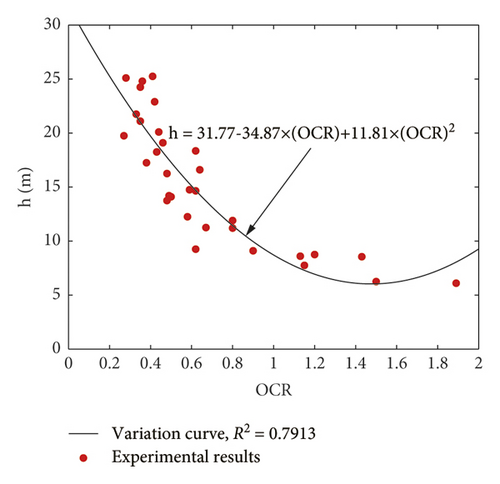
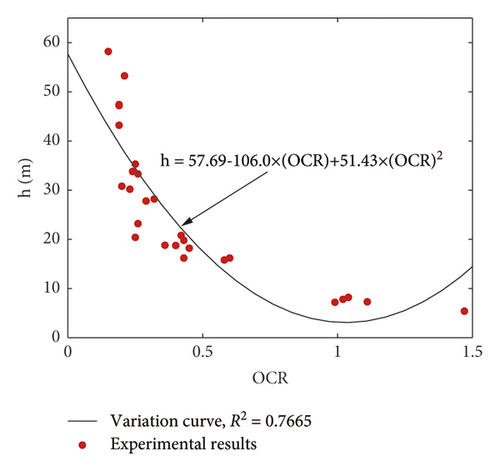

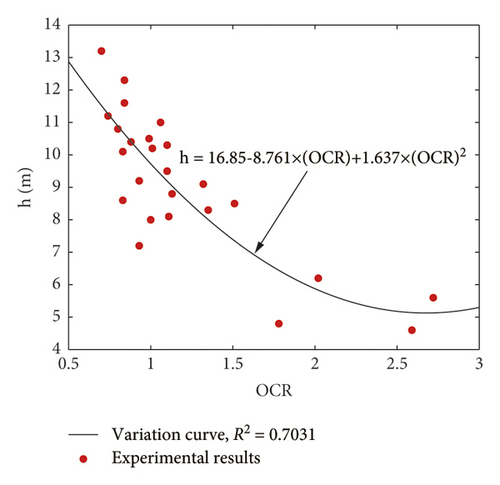
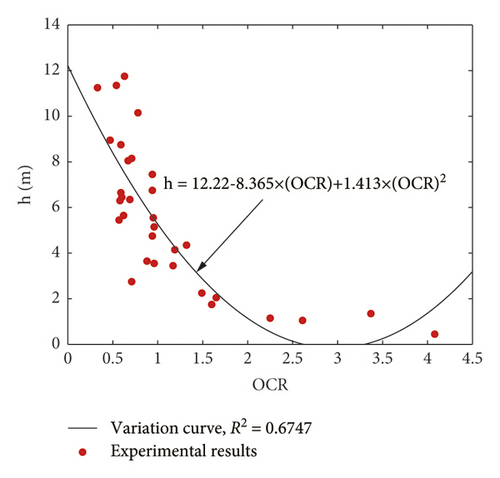
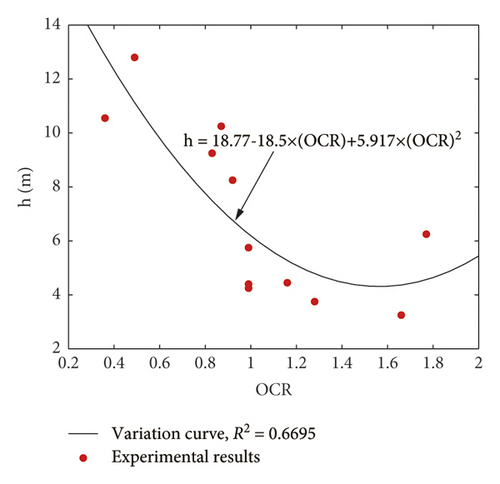
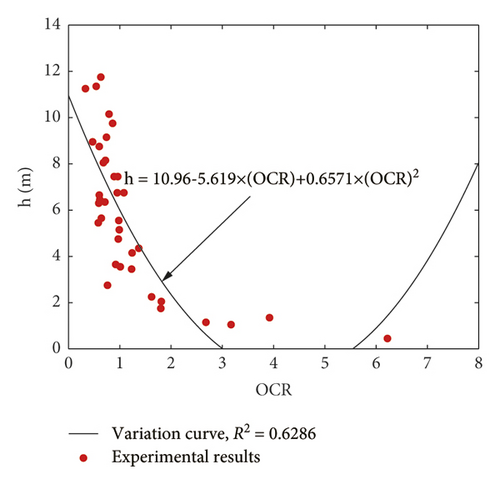
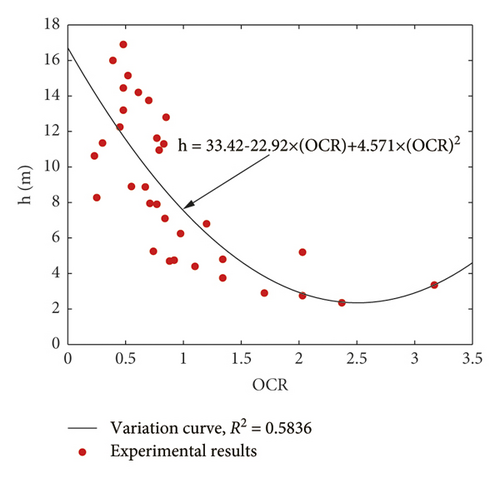
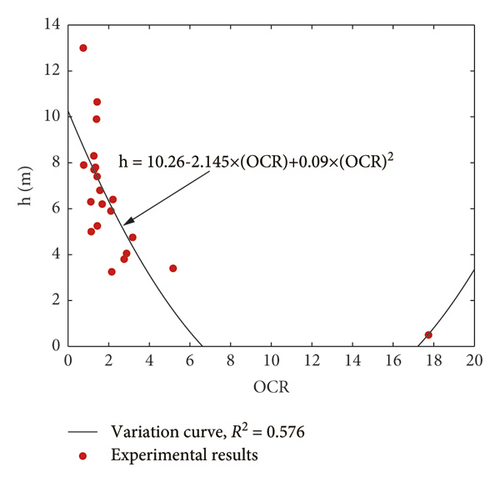
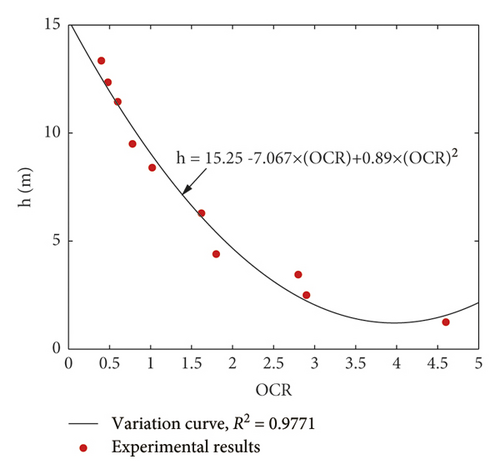
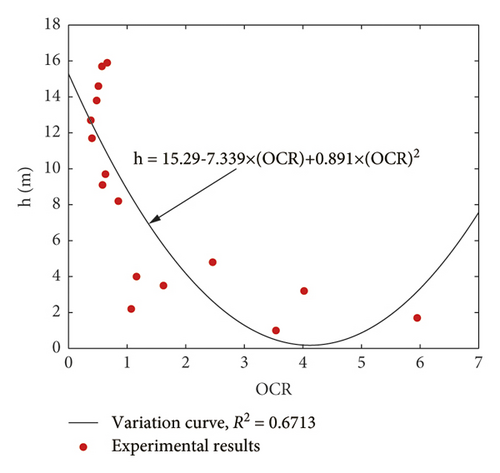
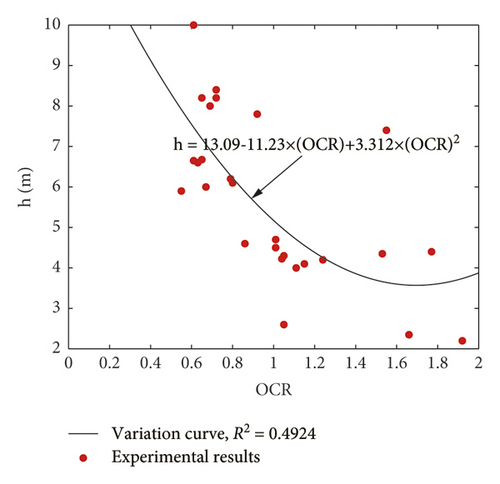
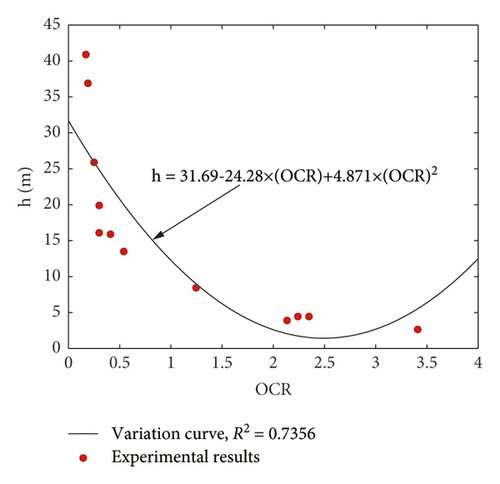
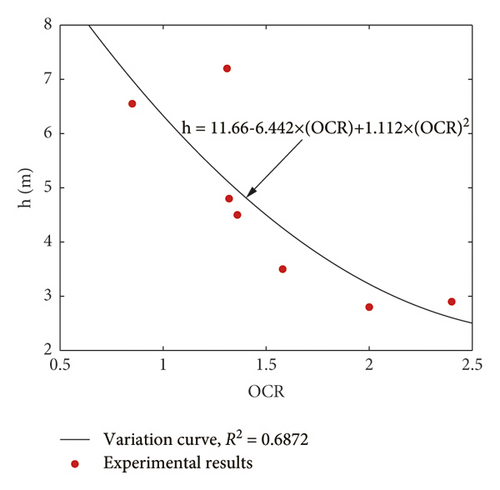
| City | a | b | c |
|---|---|---|---|
| Guangzhou | 10.96∼53.65 | −5.62∼−56.35 | 0.53∼15.62 |
| Shenzhen | 13.09∼15.25 | −7.07∼−11.23 | 0.89∼3.31 |
| Jiangmen | 28.18 | −17.46 | 3.16 |
| Zhuhai | 27.9∼57.69 | −105.98∼−34.90 | 3.3∼51.43 |
| Zhongshan | 11.66∼31.69 | −6.44∼−24.28 | 1.11∼4.87 |
3.2. Analysis of Overconsolidation Variation Law
From Table 2, it can be concluded that the parameters of the Shenzhen regional soft soil model change little, but the difference of soft soil in other cities varies greatly.
The depth corresponding to the normal consolidation state was calculated and analyzed by the CurveExpert1.4, as shown in Table 3. According to Table 3, the depth of normal consolidation is strongly dependent on both the average thickness of the overfill and the range of water level. It shows that the maximum normal consolidation depth of the Guangzhou, Jiangmen, or Zhongshan silt layers is more than 10 m, whereas that of Shenzhen and Zhuhai is less than 10 m. It can also be seen from Table 1 that the main physicomechanical properties of the Guangzhou and Jiangmen silts are similar, while those of Shenzhen and Zhuhai are similar.
| City | Average thickness of overfill (m) | Range of water level (m) | Depth of normal consolidation (m) |
|---|---|---|---|
| Guangzhou | 0.6∼6.4 | 1∼4 | 5.27∼12.92 |
| Shenzhen | 3.8∼13 | 1∼3 | 5.17∼9.07 |
| Jiangmen | 2.28 | 10 | 13.88 |
| Zhuhai | 1.8∼4.82 | 0.15∼3 | 7.38∼9.89 |
| Zhongshan | 2.22∼7.6 | 1.2~2.88 | 6.33∼12.28 |
The root cause of the above phenomenon is related to the consolidation history of the mud. The mud geomorphology unit in Guangzhou and Jiangmen is the alluvial plain of the Pearl River Delta, while that in Shenzhen and Zhuhai is the sedimentary geomorphology unit of the sea-land interaction.
4. Conclusion
- (1)
In the Guangdong-Hong Kong-Macao Greater Bay Area, the deeper the silt depth is, the smaller the overconsolidation ratio is, and the overconsolidation state eventually changes to the underconsolidation state.
- (2)
The shape of the variation curve of the overconsolidation ratio with the depth is similar to that of the compression curve.
- (3)
The depth of normal consolidation is strongly dependent on both the average thickness of the overfill and the range of water level. The maximum normal consolidation depth of the Guangzhou, Jiangmen, or Zhongshan silt layers is more than 10 m, whereas that of Shenzhen and Zhuhai is less than 10 m.
- (4)
The parameters of the Shenzhen regional soft soil model change little, but the difference of soft soil in other cities varies greatly.
- (5)
Based on the results, a developed model of the polynomial relationship between OCR and h is established.
The strength of the model is that the equations are simple and suitable for calculating the overconsolidation ratio of soft soil in the major cities of the Guangdong-Hong Kong-Macao Greater Bay Area, while the weakness is that there still remains a certain error in the overconsolidation characteristics of the soil in situ due to the use of the experimental data of the disturbed soil sample.
The sampling points in this paper cover major urban areas in the Guangdong-Hong Kong-Macao Greater Bay Area, and the conclusions drawn need to be verified by further expanding the sampling points.
Conflicts of Interest
The authors declare that there are no conflicts of interest.
Authors’ Contributions
Dashu Guan contributed to methodology, investigation, and writing of the original draft; Guoqing Zhou contributed to resources and validation; Wei Zhang contributed to software; QiYin Zhu, Jiaxi Zheng, and Wenhao Huang contributed to supervision, writing, review, and editing.
Acknowledgments
The authors are grateful for the financial support from the Guangdong Polytechnic of Water Resources and Electric Power (cy0604zk06), the Scientific Research Innovation Platform of Guangdong Polytechnic of Water Resources and Electric Power (cy0603yz02), and the Special Fund for Science and Technology Innovation Strategy of Guangdong Province (Special Fund for Climbing Plan (pdjh2022b0888)).
Open Research
Data Availability
Some or all data, models, or codes that support the findings of this study are available from the corresponding author upon reasonable request.“




